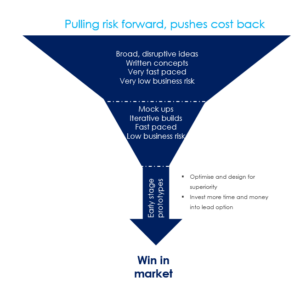What do we mean by Innovation?
‘Innovation’ is one of those words that is everywhere; we hear it every day. It’s thrown around as a challenge, as an objective and as a badge of honour. Be more innovative. We need to be more innovative. We are innovative. Yet what ‘innovative’ and ‘innovation’ means is vague and varied. It means different things to different people and different companies.
As an industry, we talk about innovation a lot – as a creative art and a fantastical answer to all of problems: we talk about innovation days, pipelines, workstreams – sharing techniques to help get the best ideas from people, but what we don’t talk about is how to do it. Physically, how do we take innovation from an idea (trust me, thinking of the innovation is the relatively easy bit!) to final delivery?
How do we overcome barriers? How do we set realistic KPIs? How do we measure success? How do we know when to red flag or when to go full steam ahead? Like it or not, despite the reputation innovation has for being the pinnacle of creativity, it’s actually a process. To successfully get innovation off the ground, across sectors, it takes 10% creativity and 90% relentless practicality.
What is The Campaign for Innovation all about?
At Blue Yonder, we have decided to get answers to these questions from client side experts for client side teams: we created The Campaign for Real Innovation – bringing senior voices from global giants together to demystify innovation, making it accessible for the first time – delivering both inspirational and practical frameworks to the table to change the way our industry works. Contributors brought many years of experience from companies such as Kellogg’s, Mars, Nestlé, Reckitt, Danone, Unilever, Diageo, Ferrero, General Mills and Mayborn Group to name just a few – sharing their tips for making innovation happen – and lessons they learnt the hard way.
Over the past 18 months, I have learnt more about the innovation process than I have in the previous 13 years of my career; at Blue Yonder, we have learnt from the best, and are now delighted to share those learnings with the world.
So why are we doing this? Why do we need to innovate in the first place? Because if we don’t innovate, we die. Because if we all do the same things in the same way, we lose our competitive edge – we don’t grow. Because if you’re not innovating, your competitors will be – and that means they will win. Don’t let them. It’s not just about the commercial – it’s about making lives better, making more sustainable futures – and, quite honestly, it’s also about having fun as inquisitive and evolutionary humans.
We’re just at the start of this journey – but let me share a few of the things we have learnt: a solid foundation on which to build.
14 Steps to build solid foundations for innovation
1. Understand what innovation means to your company
It’s not simply something that is ‘new and different’: it has to be something that is new and different which truly meets needs – that makes lives better. It must bring a real world advantage to the end user – something that direct competitors, indirect competitors and coping mechanisms cannot fulfil. It starts with a human problem: what challenge are we trying to solve? Fundamentally, innovation has to meet needs: these can be emotional, functional, hedonistic and beyond… but keep that need at the front and centre of all development. It is your compass.
2. Understand the type of innovation you are doing
The 70:20:10 rule is the traditional route for success.
a. 70% of the focus should be on regenerative innovation – iterative changes such as flavour extensions which drive short term success. They are easily understood by consumers, stakeholders and buyers. The commercial return on this pays the wages (and bonuses!) of today and funds innovation beyond the core. This is the way to grow your core.
b. 20% of focus should be on step change innovation: think of this as something adjacent to the current offer, but easily recognisable. In FMCG, this could be entrance into a new format in the same category.
c. Just 10% of time should be dedicated to disruptive stuff, but you need to do it. You need to start it today to deliver in the future. By the time it lands in market, your iterative and step change innovation may well have paved the way. This is the stuff that changes the game.
In tumultuous times, this ratio is changing slightly – we’re seeing a need for more disruptive innovation which has to work harder to deliver more immediate returns.
3. Know precisely what you want to achieve
Both defining innovation and understanding the type of innovation link to the purpose of innovation: know precisely what you want to achieve with your innovation and ensure you set the right KPIs. For the majority of companies, the primary purpose for innovation is to ensure survival – to future-proof the commercials of the business. Rightly so. But sometimes, the purpose can be less immediately commercially beneficial, instead displaying other advantages: these are often more sustainability orientated – we ensure the survival of the company (and the planet) in other ways.
To measure the success of innovation, you need to keep the purpose of it front and centre. So often, innovation is only measured by the first year commercial success. Bad decision. Yes, for core regeneration, this is a key metric, but for step change and disruptive innovation, we can’t expect immediate returns: by the nature of these products, they require behavioural change – and that takes time. Instead, consider new KPIs: these could be innovation equity – increased number of conversations with retailers or it could be as simple as volume of likes on social media.
Disruptive innovation slowly but surely changes expectations of existing categories – so never under-estimate the value of having something in this space. Think about lean start ups with over-promising claims: they may not steal market share (and we all know they don’t usually deliver what they say they will) BUT people begin to think differently about products that do exist: they begin to expect the over promise: the parameters of the category begin to change.
Take the Roomba as a prime example. No matter what type of cyclone-based vacuum Dyson bring out, it still takes more manual effort than a little machine that does the hard work for me (whilst my cat sits on it) – my aspirations and expectations have changed (and so have my cat’s). Dyson are wonderful examples of innovators in the step change space (they take their tech and move it into different categories), but often play less in the disruptive arena in the current market. Roomba’s innovation has brought a whole new set of expectations to the table.
4. Remember, that innovation is beyond product
The innovative edges are also to be found in marketing and supply chain.
M&S turned a ready meal into an experiential ‘Dine in for 2 for £10’ restaurant challenger through innovative comms. McDonald’s rarely deliver products which are truly revolutionary – (they pick a country as stimulus and create a flavour to match) – their innovation sits in supply chain.
Logistically, disruptions in the world (think Covid, Brexit, the blockage in the Suez Canal, tensions between China and USA, Russia and Ukraine) have huge implications for manufacturers: some of the innovation in this space sees supply brought more locally, sometimes even internally. This allows adaptations to be made quickly and more cost efficiently, even if initial outlay is higher: products can be adapted to changing needs much quicker, so the competitive advantage is not lost, and innovations can spend longer time in the market.
You have your definition, your purpose and your type of innovation sorted… but you also need to open up the ideation funnel…
5. You need to know why you exist
When brands focus on ‘what’ they are, rather than their purpose, they get stuck in regenerative innovation and optimisation cycles.
Take the rail roads in America: they were hugely successful 150 years ago – their purpose was to transport goods and people long distances quickly and efficiently. Slowly but surely, aeroplanes started passing over head, stealing market share – goods and people. The railroad companies focused on what they were: rail road companies. If they had been looking outwards (and upwards!), and focused on their purpose – they could have innovated in the air: it met the same fundamental need. What a greetings card manufacturer does is ‘make greetings cards’; what its purpose is sits in emotionally connecting two people in a moment. This purpose driven mindset opens up countless opportunities for innovation.
6. Aim for disruption and deliver ‘step change’
The sad reality is that to deliver innovation to the market, you often have to compromise. This means that you need to think bigger – aim high – ideate around the ‘art of the possible’, and then work backwards. What are the core elements which ensure it meets the needs, delights, differentiates and disrupts? Keep these. Fight for these. But what else can you trade off to make manufacture possible, to win shelf space, or to comply with the direction set by your global marketing director?
Want five different sizes of your new product, each having an ergonomic left and right fit, in two different colours? Deliver three SKUs, left and right: two in store, one available through ecommerce. You can get that shelf space. You can get the machinery to make that…you kept the core elements of the innovation, but you compromised to make it happen.
7. Consider how your teams are set up
Where a single team (or person) is working on regeneration, step change and disruptive innovation (short, mid and long term) the focus almost always remains on the immediate solution: the regenerative, short term NPD. It’s human nature. We focus on what we can impact the most immediately. This means that the long term innovations can die on the page. It can take 2/3/5/7 years to deliver disruptive innovation – but that number starts from the second you hit ‘go’. Unless you start straight away, those number of years to final delivery will remain the same.
Think about splitting your teams: core vs step change and disruptive innovation. Ensure they communicate (the foundations for disruptive innovation are often delivered through step change paving the way), but ensure they have their own, distinct focus. The type of person who excels at ‘core’ vs ‘disruptive’ is often very different – so choose your teams wisely.
So much of delivering real world innovation is about creating a culture of innovation: it’s about mindset – and this is possibly the hardest thing to change in a business. The bonuses of C-Suite are paid based on the profits of today: so why would they invest in the more disruptive end of the funnel? The innovation mindset must come from the top.
8. Celebrate the wins and the failures in equal measure
Creating a culture of innovation is more than just giving permission for innovation to happen. It’s about empowering people to try new things – to have ideas – and to take risks. Celebrating the wins is obvious, yet so often missed: it inspires others to come forwards with their ideas…but celebrating the fails is equally crucial: why did we fail? What did we learn? Elon Musk gets further faster because he builds fast and tests: yes, his rockets explode, but he learns more from three failures than NASA learns from one slower, more expensive desire to get it right first time. What did we learn up to the point of filature and what can we learn about the decision making process that led us there?
9. Fail fast
Test high quantities of diverse, disruptive ideas and low fidelity prototypes (where applicable) early on. Very early on. Find out what people really think – what they love and hate. What really meets their needs, or what could meet their needs if you adapt them. Put in ideas which challenge thinking – give people something to respond to: we de-risk innovation by setting hard and fast ‘good and bad’ parameters at early stages: this helps minimise the risk and delivers guardrails for future development – we get where we need to go cheaper, faster and better.
10. Binnovation
Know when to kill it. Not every idea is a good idea (there is a whooolllllleeee session on when to ‘red flag’ coming up!) Understand WHY it wasn’t a good idea, then accept it and move on. (Full credit to Jonathan Million for the ‘binnovation’ term!)
11. Sleep with everyone in the room
Stakeholder buy-in is one of the greatest barriers to innovation. The key to getting them on board is to speak their language: haven’t got sales data to support your business case because the product doesn’t exist yet? Take data from adjacent categories and show potential. Marketing thinks the idea is too far? Draft a concept – share it as stimulus, not as a final idea: you need their help to make it happen. Need R&D to understand what needs to be built? Build it out of cardboard. Film your friend/wife/dog using it/talking about it (whatever ‘it’ is) show them it has legs: all you need is permission, and a little money, to unlock the next stage.
And finally, as Ben Diamant so powerfully says:
12. Everything starts with the consumer
13. Everything starts with the consumer
14. Everything starts with the consumer
Do you REALLY know your end user. Do you know the real world context of their product or service usage? Do you know what they use, why they use it and how they use it? Do you know your competitive set? Do you know your own product or service inside out? What are the real world, human problems you are trying to solve with your innovation? What are their needs? What will delight them? What will frustrate them? What do they want to see? Only when you have triangulated all the answers to these questions can you start to think about the innovation itself.
Summary: Innovation Foundational Thinking
It’s a lot to take in, I know – and this is just the starting point: the foundational thinking. There is so much more I could have written…but we have to draw the line somewhere.
The real question is: where do you start in the real world when we’re talking about huge, unwieldy global giants? We can’t change everything in one go. Our advice is to start small. Start with a SWOT analysis of what is within your control: what can you change within your business? Who else shares your mindset… find allies, make friends… and take the first steps in a long journey together.
Innovation is tough; it is hard. It takes patience, and tenacity and a lot more ‘people’ skills than people think. You do need to pause, progress and pivot – all the time. There will be barriers to overcome (more on that later!), but they can be overcome: remember, innovation is 10% creativity and 90% relentless practicality.
Join us on our quest to demystifying innovation and make it accessible to all: join us in The Campaign for Real Innovation.
Published on 10th February 2023.
Credits
A huge thank you to Dr. Lara Ramdin (for putting me on the right path), Tiana Conley, Ben Diamant, Neil Patel, Michelle Roberts, Michel Bonnet, Paul Thomas and Emma Goff for your support with this: your expertise has had a real impact already. I look forward to seeing what the future holds!





Stay In Touch